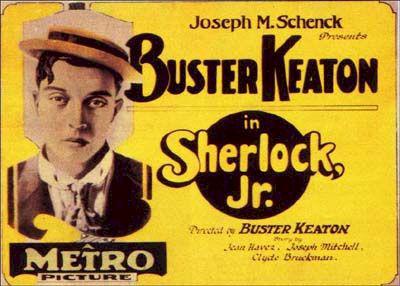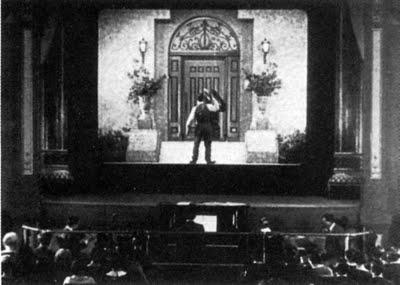
Some express surprise that the film was, in its time, Keaton's least-grossing feature, and its whittled length was the result of negative feedback prompting the artist to cut out chunks of footage. But the sheer strangeness of the movie, its self-reflexive, forward-thinking structure and narrative, must have alienated audiences unprepared to deal with its implications and technical prowess. The General may be Keaton's masterpiece, but it is this movie, even more unjustly ignored by initial audiences, that best proves how ahead of his time the man truly was.
By throwing his projectionist into the movie shown within the movie, Keaton, known for his stoicism and immovable face, is the first to tackle the magic and wonder of movies head-on, and not even that impassive mug of his can hold back a deep feeling of love and fulfillment. He dives into the material with immaculately construction, using surveying equipment to ensure the precise distance between camera and actor to make Keaton's initial daydream of walking into a film frame look possible. When he gets to the narrative of the film within a film, it proves identical to the narrative that started the main movie, instantly blurring distinctions between reality, the film's diegetic world and that of the movie within the movie.
Jilted in "real life" when a rival suitor (Ward Crane) sabotages Keaton's courtship of a young woman (Kathryn McGuire), the projectionist finds himself in a detective story revolving around a case remarkably similar to the one that ejected Keaton from the girl's home. Is it coincidence? If so, how can Keaton enter the second film as the titular detective without any disruption in that narrative?

But these are technical, fussy questions, and Sherlock, Jr. is about the wish-fulfillment of all moviegoers, the chance to step into the screen and interact with these looming demigods, even if only to give ourselves a second chance at our own lives through the aggrandizing power of cinema. No longer is Keaton the poor lackey who wistfully reads a how-to book on detective work in his off-time; instead, he is the heir of Holmes himself, though the real chap's ineptness still shines through. One title card not only highlights Keaton's lingering lack of forensic skill with genre parody when it says, "By the next day the mastermind had completely solved the mystery—with the exception of locating the pearls and finding the thief."
To ignore the technical questions raised by the film, however, would be to ignore the carefully planned intricacy of Keaton's staging. Besides the aforementioned spatial perfectionism for the initial metacinematic gag of Keaton "interacting" with a constantly changing location within the screened film, Keaton uses the blatant movie-movie structure to stage some grand stunts that make use of the film's translucence. A climactic bike chase not only strings together numerous death-defying stunts but relies more on transparently false staging than his usual gag for even larger setpieces. Even before Keaton steps into the film, he throws in a huge gag, running on the top of a train until he must cling to the faucet of a water basin, unleashing hundreds of gallons onto him in seconds. Keaton suffered fracturing from the force of the water and suffered migraines the rest of his life for it. Even smaller gags are incredible: Keaton's leap through a tie vendor's briefcase of wares predates the painted tunnel jokes in Wile E. Coyote/Roadrunner cartoons by a full 25 years.
Cognizant of real-world concerns of the working class, Keaton juxtaposes such grand stunts with simpler, class-conscious humor. The first great bit of the movie involves no stunt work whatsoever: the projectionist, cleaning up some trash outside the theater, finds a dollar, which gives him enough cash for that nice box of chocolates, only for a woman to walk by and say she lost a dollar. In his desire to keep the cash, Keaton asks her to describe it, an amusing bluff matched by her cheating as she looks over his shoulder to gauge the shape and dimensions, as if money really were scarce enough that one would be unsure of its look. Later, Keaton breaks out an engagement ring for the woman, a gold band so hysterically cheap that the blip on its thin strip looks less like a diamond than a zit. Hilarious as these touches are, they provide a vital, real counterpoint to the movie magic to come, making the escapism all the more appealing. I wonder if this movie would have performed better if it premiered during the Depression, when everyone recognized and knew poverty and ticket sales for escapism soared. Perhaps, then, the film's biggest commercial issue is that is nostalgic for an artform too young to elicit feelings of wistfulness.
The finale, back in the regular film but framed against the screening movie, finds the balance between cinematic wonder and reality, showing Keaton looking to the movies for instruction for reality even as the movies themselves come from our idealized visions of the world as it exists. His copycat romance is Keaton's final statement on cinema, reality informed by fiction informed by reality. It's a constant loop of self-improvement, reality made to fit our fantasies, which in turn become loftier and more romantic to remain dreams. Keaton later said he "just wanted it to look like a dream," but that's what makes it such an enduring movie about movies. Cinema itself is a dream, and few movies come close to capturing the feel Keaton mastered in the medium's infancy.

